Articles
- Page Path
- HOME > J Korean Powder Metall Inst > Volume 25(1); 2018 > Article
-
Review Paper
원자층증착법을 이용한 수소 생성용 광전기화학 전극 소재 개발 동향 - 한정환*
- Recent Developments in H2 Production Photoelectrochemical Electrode Materials by Atomic Layer Deposition
- Jeong Hwan Han*
-
Journal of Korean Powder Metallurgy Institute 2018;25(1):60-68.
DOI: https://doi.org/10.4150/KPMI.2018.25.1.60
Published online: January 31, 2018
서울과학기술대학교 신소재공학과
Department of Materials Science and Engineering, Seoul National University of Science and Technology, Seoul 01811, Republic of Korea
- *Corresponding Author: Jeong Hwan Han, +82-2-970-6636, +82-2-973-6657, jhan@seoultech.ac.kr
• Received: February 5, 2018 • Revised: February 17, 2018 • Accepted: February 17, 2018
© The Korean Powder Metallurgy Institute. All rights reserved.
- 577 Views
- 2 Download
- 1 Crossref
Abstract
- The design and fabrication of photoelectrochemical (PEC) electrodes for efficient water splitting is important for developing a sustainable hydrogen evolution system. Among various development approaches for PEC electrodes, the chemical vapor deposition method of atomic layer deposition (ALD), based on self-limiting surface reactions, has attracted attention because it allows precise thickness and composition control as well as conformal coating on various substrates. In this study, recent research progress in improving PEC performance using ALD coating methods is discussed, including 3D and heterojunction-structured PEC electrodes, ALD coatings of noble metals, and the use of sulfide materials as co-catalysts. The enhanced long-term stability of PEC cells by ALD-deposited protecting layers is also reviewed. ALD provides multiple routes to develop improved hydrogen evolution PEC cells.
- 에너지의 고갈 및 화석 연료의 사용 증가로 인한 환경 문제가 대두됨에 따라 수소 연료와 같은 청정 에너지원의 개발에 대한 관심이 높아지고 있다. 현재 수소 연료를 생 성하기 위한 방법으로 화석연료의 리포밍(reforming) 방법 을 주로 사용하고 있지만 이 경우 수소 생성 과정에서 이 산화탄소가 발생하기 때문에 이를 대체할 친환경적이며 경 제적인 수소 연료 생산 방법을 개발하는 것이 필요하다. 대 표적인 친환경적 방법으로 광화학 및 광전기화학적 물분해 법이 있으며, 1972년 Fujishima와 Honda에 의하여 TiO2 소재를 기반으로 한 광촉매 소재가 처음으로 보고된 이후 WO3, Cu2O, CdS, ZnO 등과 같은 다양한 촉매전극소재가 연구되고 있다[1-4]. 그림 1은 n형 반도체 기반의 광전기 화학적 물분해 메커니즘을 보여준다[5]. 높은 효율의 광전 기화학적 물분해 반응이 이루어지기 위해서는 다음과 같 은 다양한 광촉매전극 소재 요구 조건을 만족해야 한다. 첫째, 반도체 소재는 태양광을 효과적으로 흡수하여 전 자-정공쌍을 생성할 수 있도록 적절한 밴드갭(Band gap) 을 가져야 한다. 둘째로 수소 생성 전극 소재는 전도띠 (conduction band)의 에너지 준위가 수소 생성 준위 보다 음전위에 위치해야 하며, 반면 산소 생성전극은 원자가띠 (Valence band)의 에너지 준위가 물의 산화에 의한 산소 생성 준위보다 양전위에 위치해야 한다. 셋째, 생성된 전 자-정공의 효과적인 공간 분리 및 전극 표면으로의 이동 을 위해 낮은 전자-정공 재결합율과 우수한 전하 전도도 를 가져야 한다. 마지막으로 전해질 용액상에서 높은 화학 적 안정성 및 광부식성이 적어 광전기화학반응 중 수소 생성 효율의 저하가 없어야 한다.
- 가장 대표적인 광촉매 반도체인 TiO2는 우수한 촉매 활 성도, 화학적 안정성, 긴 전하-정공 life time 특성 등으로 인해 많은 연구가 이루어지고 있다. 하지만 상대적으로 큰 밴드갭(3.0~3.2 eV)을 가지고 있기 때문에 전체 태양광의 5%에 불과한 자외선(λ<400 nm)에 의한 전자-정공쌍만을 생성해 높은 효율의 수소 생성 촉매전극소재 개발에 한계 가 있다[6, 7]. 이를 개선하기 위하여 전이 금속(Cr, Fe, V, Mn, Cu 등) 및 비금속(N, S, C 등) 도핑을 통해 밴드갭을 줄이는 연구 또는 CdS와 Cu2O와 같이 2.0~2.4 eV의 작은 밴드갭을 가지는 물질을 이용하는 연구가 수행되고 있다 [8-11]. 그럼에도 불구하고 광부식에 인한 수소 생성 효율 의 저하 또는 전자-정공쌍의 빠른 재결합 특성으로 제한적 인 수소 생성 특성을 보이고 있다[12, 13]. 이외에도 WO3 나 Fe2O3는 광전극촉매로써 적절한 밴드갭(2.2~2.6 eV)을 가지고 있어 주목을 받고 있으나 낮은 전하 전도도, 제한 적인 캐리어 확산 거리, 높은 과전압(overpotential) 등 여전 히 고효율화를 위한 촉매전극소재의 개선이 요구되고 있 다[14, 15]. 대표적인 촉매전극 소재 개선 방법으로 1) 3차 원 나노구조체 촉매전극개발을 통한 반응 표면적 증대 및 광흡수율 개선, 2) 이종접합구조(heterojunction structure) 반도체 촉매 소재의 합성을 통한 태양광 반응성 향상 및 효율적 전하 분리, 3) 귀금속 나노 입자 담지를 통한 반응 속도 향상, 4) 전극소재 표면 코팅을 통한 소재 내구성 향상 의 연구가 시도되고 있다. 촉매전극 소재 개량을 위하여 기존 에 활용되는 소재 합성 공정으로는 함침법(impregnation), 담 지-침전법(deposition-precipitation). 졸겔법(sol-gel), 광증착법 (photodeposition), 이온주입법(ion implantation) 등이 있다 [16-19]. 이때 광촉매전극을 활용한 물전기화학분해 수소 생성 효율은 이온의 도핑 특성, 전극 소재의 표면 및 계면 특성, 담지 귀금속의 크기 및 밀도, 3차원의 전극 구조체 의 특성 등에 매우 민감하게 영향을 받기 때문에 정밀한 소재 합성 및 이를 위한 공정 기술은 매우 중요하다.
- 한편, 원자층증착법(Atomic Layer Deposition, ALD)은 그림 2에 나타낸 바와 같이 금속 전구체와 반응가스의 교 차 주입을 통한 자기 제한적 표면반응에 기인한 화학기상 증착법으로 주로 반도체 공정에 활용되고 있는 박막 코팅 기법이다. 최근에는 ALD의 매우 우수한 장점인 정확한 두께 제어 및 삼차원 구조에서의 균일한 단차 피복 특성 을 이용하여 촉매, 에너지 저장, 에너지 발전 소재와 같은 복잡한 구조의 소재 고기능화 연구에 활용되어지고 있다 [20]. 본 리뷰에서는 ALD 공정을 활용한 광전기화학적 물 분해용 촉매전극 소재 개발 동향들에 대하여 고찰하고자 한다. 2장에서는 ALD 공정을 적용하여 3차원 광촉매 소 재 개발, 이종접합구조 촉매 소재 개발, 귀금속 및 황화물 담지 촉매 소재 개발, 내구성 향상을 위한 전극 보호막 코 팅 기술 개발에 대하여 각각 기술하였다.
서 론
Fig. 1
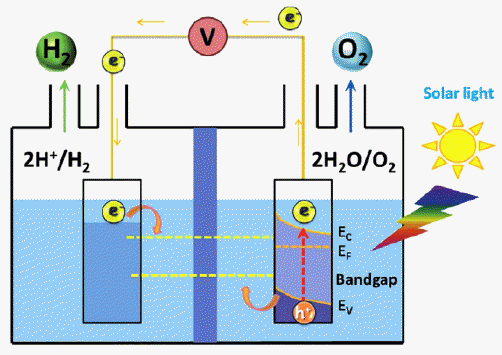
Schematic of the basic principles of water splitting for a PEC cell with an n-type semiconductor photoanode (where oxygen is evolved) and cathode (where hydrogen is evolved). Reproduced with permission [5], Copyright 2014, Royal Society of Chemistry.

Fig. 2
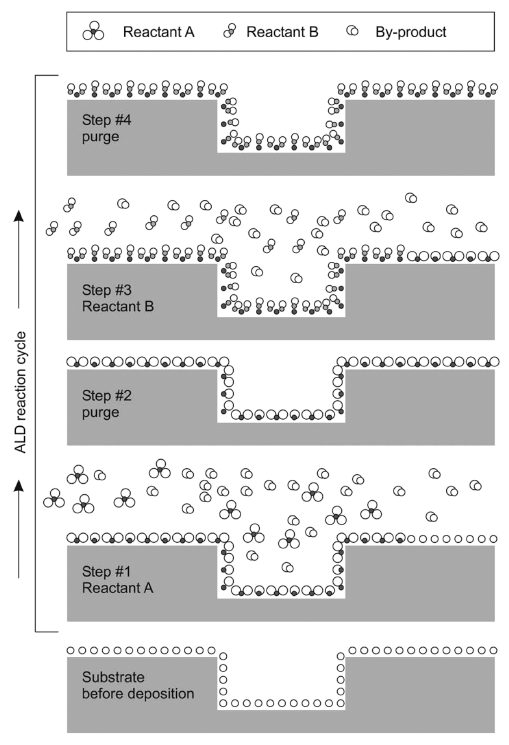
Schematic illustration of one ALD reaction cycle, Reproduced with permission [20], Copyright 2005, AIP Publishing LLC.

- 2.1. ALD를 이용한 3차원 전극 소재 개발
- 전술한 바와 같이 높은 성능의 수소 생성용 광전기화학 셀을 개발하기 위한 방법으로 3차원 구조의 전극을 제조 하려는 연구가 수행되고 있다. 이러한 다공성 구조의 3차 원 광촉매전극 개발은 전극과 전해질 계면의 비표면적을 넓혀 수소 생성 반응 효율을 높일 수 있으며, 복잡한 전극 구조로부터 태양광 포획율을 높일 수 있다는 장점이 있다. 3차원 구조의 광촉매전극을 제조하기 위한 방법으로 Si 나 노와이어, TiSi2 나노네트, CNT, 전도성 산화물 나노입자, Inverse opal 구조와 같은 복잡한 구조의 전도성 지지체상 에 ALD를 이용하여 다양한 반도성 산화물 박막을 균일하 게 코팅하는 연구가 발표되었다[21-25].
- 이 중 CNT 전극은 넓은 표면적, 우수한 전기전도도, 열 안정성 등의 특성으로 인해 촉매전극 지지체로 많은 연구 가 이루어졌으며 TiO2, Fe2O3, Co3O4 등 다양한 촉매 물질 을 ALD 공정을 이용하여 코팅하였다. TiO2 박막은 TiCl4 와 H2O를 이용한 ALD 반응을 통하여 복잡한 구조의 CNT 상에 균일한 두께로 형성 할 수 있었으며 더 나아가 TiCl4 공급 시간을 조절함에 따라 CNT/TiO2 코어쉘 구조 에서 TiO2 촉매층 두께를 정밀하게 제어할 수 있었다. 이 를 통해 우수한 촉매 특성을 갖는 CNT/TiO2 코어쉘 구조 의 촉매전극 소재의 개발 및 최적화를 할 수 있었다[22]. 이성분계의 TiO2뿐 아니라 FeSx ALD 및 CoSy ALD를 이 용한 3성분계 FexCo1-xS의 황화물을 CNT 전극 위에 코팅 한 결과가 보고되었으며 ALD의 우수한 조성 제어 특성을 바탕으로 최적의 수소 생성 특성을 갖는 3차원 전극을 개 발 하였다(그림 3(a)). 그림 3(b)~(d)에 나타낸 바와 같이 Fe0.54Co0.46S0.92/CNT/CC 전극이 가장 우수한 수소 생성 반 응 특성을 보였으며 특히 -10 mA/cm2 의 전류 밀도를 얻 기 위하여 -158 mV의 낮은 과전압 특성을 나타냈다. 또한 Tafel slope을 통해 Fe0.54Co0.46S0.92 조성의 전극이 다른 조 성의 FexCo1-xS 황화물 박막과 비교하여 가장 높은 활성도 를 보임을 확인하였다[25].
- TiSi2 nanonet은 CNT와 마찬가지로 우수한 전도도 및 높은 표면적을 가져 광촉매 코팅을 위한 지지체로써 적합 한 소재이다. Lin et al.은 TiSi2 nanonet에 ALD 공정을 이 용하여 물분해를 위한 TiSi2/Fe2O3 광전기화학 촉매전극을 제작하였다. 그림 4에 나타난 바와 같이 ALD에 의해 균 일하게 코팅된 TiSi2/Fe2O3 3차원 전극 소재는 2차원 구조 의 광전기화학 촉매 전극과 비교하여 우수한 전류밀도 및 광전변환 효율을 나타냄을 확인하였다[23].
- 2.2. ALD를 이용한 산화물 이종접합구조 광촉매 전극 소 재 개발
- 태양광 에너지로부터 높은 효율의 광전기화학 반응을 얻기 위해서는 먼저 생성된 전자-정공쌍의 재결합을 줄이 기 위하여 전하를 효율적으로 분리하고, 자외선 영역뿐 아 니라 가시광선 영역의 태양광에 대한 광반응성이 우수한 소재의 활용이 필요하다. 이러한 이유로 최근 ALD를 이 용하여 이종접합구조의 광촉매전극소재를 개발하려는 노 력이 많이 이루어지고 있다.
- Li et al.은 Fe2O3/Fe2TiO5 구조의 나노막대 이종접합구 조의 광촉매전극을 제조하여 그림 5에 나타낸 바와 같이 Type II 밴드구조의 전극 형성을 통해 광전기화학적 물분 해 반응 중 전하분리특성을 개선하였음을 보고하였다[26]. 3차원 나노 막대 구조의 광촉매 전극은 FeOOH 나노막대 상에 Tetrakis(ehylmethylamino)titanium 전구체와 물을 이 용하여 TiO2 를 코팅하고 후 열처리를 하는 방법으로 제조 하였다. 이러한 방법으로 제조한 Fe2O3/Fe2TiO5 전극은 bare Fe2O3와 비교하여 전류밀도가 1.63 mAcm-2(at 1.23 V)으로 3.5배 향상되었음을 확인하였다. 또한 CdS 나노입자에 ALD ZnO 박막을 코팅한 Z-scheme 코어쉘 구조 촉매를 제작함으로써 물분해를 통한 수소 생성 효율을 크게 향상 시킬 수 있음이 보고되었다. 이때 광전기화학적 특성은 ZnO 쉘의 두께에 따라 달라짐을 확인하였으며 100 cycle 의 ZnO ALD 공정 시에 11.13 mmol/g/h의 가장 우수한 수 소 생성 특성을 확보하였다[27]. 향상된 수소 생성 특성은 이종접합구조촉매의 우수한 전하 분리 및 전하 전달 특성 에 기인한 것으로 보여진다. 이 외에도 ALD를 이용한 Si/ Fe2O3, ZnO/TiO2, TiO2/Fe2O3 등 다양한 이종접합촉매전극 의 제조 및 향상된 전하분리 및 전달 특성이 보고되었다 [28-31].
- 광전기화학 반응 효율을 개선하기 위한 다른 방법으로 TiO2와 같은 UV 반응성 촉매에 2.0~2.5 eV의 가시광선영 역에 해당하는 밴드갭 에너지를 갖는 Co3O4와 같은 반도 체를 접합하여 촉매전극의 광반응성을 향상시키는 연구가 진행되고 있다[32, 33]. 그림 6(b)는 TiO2 나노튜브에 ALD 를 이용하여 2.07 eV의 밴드갭을 갖는 Co3O4 박막을 코팅 한 Co3O4@TiO2나노 튜브 전극의 SEM 사진이다. 증착된 Co3O4박막은 Co(Cp)2와 O3을 전구체와 반응가스로 각각 이용하여 성장하였다. 적절한 밴드갭을 가진 Co3O4 코팅 을 통해 Co3O4@TiO2 나노튜브 전극의 경우 pure TiO2 나 노튜브에 비해 10배이상 광전류값이 향상되어 광반응성 매우 개선됨을 확인하였다(그림 6(a)). 이러한 특성 향상은 그림 6(c)에 나타낸 바와 같이 TiO2 위에 균일하게 코팅된 Co3O4 박막이 광반응성 향상으로 인한 전자-정공쌍 생성 및 전하 분리 특성을 개선함에 기인한것으로 보인다. Co3O4 ALD 박막 외에도 In2S3, FeOx등 작은 밴드갭을 가 진 소재와의 이종접합 구조가 연구되고 있다[34, 35].
- 2.3. ALD를 이용한 귀금속 및 황화물 담지 촉매 전극 소 재 개발
- 광전기화학 셀을 이용한 수소 생성 반응의 이슈 중 하나 는 TiO2, ZnO 등과 같은 반도체 전극-전해질 계면에서의 느린 산화 환원 반응속도로 인한 셀 특성 저하이다. 이는 앞서 언급하였듯이 느린 반응 속도로 인해 전도띠에 형성 된 전자와 원자가띠의 전공의 재결합율이 높아지기 때문 이다. 이러한 문제를 개선하기 위하여 반도체 촉매 소재 표면에 Pt, Ru, Ir등과 같은 조촉매 귀금속을 담지하여 매 우 높은 광전기화학적 수소 생성 활성도 특성을 보고하고 있다[36, 37]. 하지만 귀금속 기반 조촉매의 경우 매우 고 가의 재료이기 때문에 촉매전극으로 활용하는데 경제성 문제가 대두 되고 있고 금속 촉매의 담지량이 너무 많게 되면 오히려 태양광의 흡수가 감소하기 때문에 크기가 정 밀하게 제어된 귀금속 입자를 3차원 전극 소재에 균일하게 담지하는 공정기술 또는 귀금속을 대체할 수 있는 저가의 조촉매 황화물 소재를 개발하는 연구가 요구 되고 있다.
- Berkeley와 Stanford대학 연구팀은 p-Si NW/TiO2 코어 쉘 구조에 ALD를 이용하여 Pt 나노입자 조촉매 담지를 시도 하였다[38]. 그림 7(a)~(c)에 나타낸 바와 같이 Pt ALD 공정 싸이클 수에 따라 담지되는 Pt 입자의 크기 및 밀도를 제어할 수 있었으며 1-3 싸이클의 Pt ALD 공정만 으로 10~34 ng/cm2 면밀도의 0.5~3 nm 크기의 입자 코팅 이 가능함을 확인하였다. 이와 같이 ALD Pt 공정 기술을 통해 수소 생성 효율을 정밀하게 제어할 수 있었으며 매 우 적은 양의 Pt 코팅만으로 그림 7(d)에 나타난 바와 같 이 0.15-0.25 V의 onset 전압과 30 mA/cm2의 전류 밀도 특 성을 얻을 수 있었다. 이 밖에도 Pt ALD 공정을 이용하여 TiO2 나노와이어, Al2O3 나노 입자, glassy carbon등 다양 한 지지체에 Pt를 담지하는 보고가 있다[39-41]. 더 나아 가 우수한 촉매 특성의 소재를 개발하기 위하여 Pt-Pd, Pd-Ru, Pt-Ru 등의 이종귀금속 촉매 또한 ALD 기술의 정 밀한 조성 제어 특성을 이용하여 제조한 발표가 있다[42].
- 최근에는 고가의 귀금속 촉매를 대체하기 위하여 안정 성이 우수하며 저가의 MoS2 또는 NiS와 같은 금속 황화 물을 ALD법을 이용하여 광촉매소재로 활용하려는 연구 가 주목을 받고 있다[43-45]. MoS2 박막은 Mo(CO)6와 H2S 플라즈마를 전구체와 반응가스로 이용하여 성장할 수 있다. 이때 ALD 싸이클 수 조절 및 후 열처리 공정 조건 을 통해 막의 형태, 두께, 조성 등을 제어 할 수 있음을 확 인하였다. 최적화된 MoS2 성장 조건하에서 Si 전극위에 14 nm 두께의 ALD 공정을 통해 MoS2/Si 전극을 형성한 후 수소생성반응 평가를 수행한 결과 21.7 mA/cm2의 광전 류밀도(0V(Vs. RHE))와 0.23 V의 개시전압을 가져 Pt 코 팅된 Si 전극과 비교하여 우수한 수소 생성 성능을 확보 하였다[43]. 또한 Ni(amd)2와 H2S가스를 이용하여 NiS ALD공정을 개발 하였고 개발된 박막의 수소 생성 촉매 특성을 평가하였다. FTO전극위에 NiS 박막을 형성함으로 써 매우 적은양의 NiS만으로도 우수한 전기화학적 촉매 특성을 보였으며 산성과 중성의 phosphate buffer aqueous media상에서 각각 440 mV 및 576 mV의 과전압을 나타냈 다[44].
- 2.4. ALD를 이용한 촉매전극 보호층 소재 개발
- 수소 생성을 위한 광전기화학 반응 기술의 상용화에 있 어 가장 해결되어야 할 기술적 과제 중 하나는 광전기화 학 반응 중 촉매전극 소재의 부식 및 이로 인한 효율 저 하이다. 이러한 광촉매전극의 부식을 완화하기 위한 방법 으로 화학적으로 안정한 보호막 박막, 예를 들어 산화물, 고분자, 카본층 등을 전극 표면에 코팅하는 연구가 활발히 이루어지고 있다. 이때 우수한 전기화학 활성도 및 내구성 을 갖기 위해서 보호막 박막은 몇 가지 조건을 만족시켜 야 하며 첫째로, 전극 표면을 균일하고 치밀하게 그리고 핀홀(pin-hole)없이 코팅할 수 있어야 한다. 둘째로 빛의 흡수를 방해하지 않도록 보호막 박막은 수-수십 nm 두께 로 충분히 얇아야 한다. 마지막으로 보호막 박막은 전하 전달이 용이하도록 충분히 전도성이 좋아야 한다. 이렇듯 균일하고 치밀한 초극박막의 보호층을 복잡한 구조의 전 극에 코팅하기 위하여 ALD기술을 적용하는 연구가 최근 다양하게 보고되고 있다[46-51].
- 다양한 보호막 중 TiO2는 우수한 전도성 및 화학적 안 정성으로 인해 많이 활용되어지는 소재이다. Li et al.은 Pt 가 담지된 Si 나노와이어의 H2SO4(0.5M) 전해질 용액내에 서(under 100 mW/cm2) 화학적 안정성을 향상시키기 위하 여 ALD를 이용한 TiO2 코팅을 하였고 이로 인한 전기화 학 특성 향상을 보고 하였다[48]. 그림 8(a)~(d)에 나타난 바와 같이 15 nm 두께의 TiO2 보호층이 ALD방법을 통해 균일하게 Si 나노와이어 상에 코팅되었음을 확인 할 수 있 다. TiO2 보호층이 없는 경우 Pt/Si 나노와이어 샘플의 광 전류 밀도 값이 초기 -24 mA/cm2에서 광전기화학반응 2 시간동안 연속적으로 감소하는 것을 볼 수 있고 반면 15 nm TiO2를 코팅한 경우 광전류 밀도 값이 감소하지 않 는 것을 확인하였다. 이는 ALD를 이용하여 코팅한 TiO2 박막이 광전기화학 특성의 저하 없이 셀의 내구성을 향상 시켰음을 의미한다.
- TiO2 보호층 코팅은 Cu2O 광음극의 내구성 향상을 위해 서도 적용되었다. Cu2O는 2 eV의 적절한 밴드갭과 에너지 준위를 가지고 있음에도 불구하고 용액 전해질 내에서의 광부식 특성으로 인해 수소 생산용 전극 소재로의 적용에 어려움이 있다. Paracchino et al.은 Cu2O 광전극 소재의 내구성 향상을 위해 ALD를 이용하여 TiO2/ZnO 또는 TiO2/Al:ZnO 보호막을 형성하여 광전기화학 반응의 전류 밀도 성능 뿐 아니라 내구성을 향상 시킬 수 있었음을 네 이처 자매지에 보고하였다[51]. 이때 TiO2 단일막 만으로 는 Cu2O의 부식 특성이 향상되지 않았으며 ZnO를 buffer layer로 적용하였을 시 내구성 특성이 크게 향상됨을 확인 할 수 있었다. 그림 9는 bare Cu2O전극과 TiO2/Al:ZnO가 코팅된 Cu2O전극의 Current-potential 특성을 보여준다.
ALD를 이용한 수소 생성 전극 동향
Fig. 3

(a) SEM images of Fe0.54Co0.46S0.92/CNTs/CC electrodes. (b) LSV curves and (c) Tafel plots for FexCo1−xSy films with various compositions. The overpotentials (η) at −10mA/cm2 in current density and the values of the Tafel slopes are plotted in panels (d) and (e), respectively. The FexCo1−xSy films were grown by ALD on flat glassy carbon substrates. Reproduced with permission [25], Copyright 2017, American Chemical Society.

Fig. 4
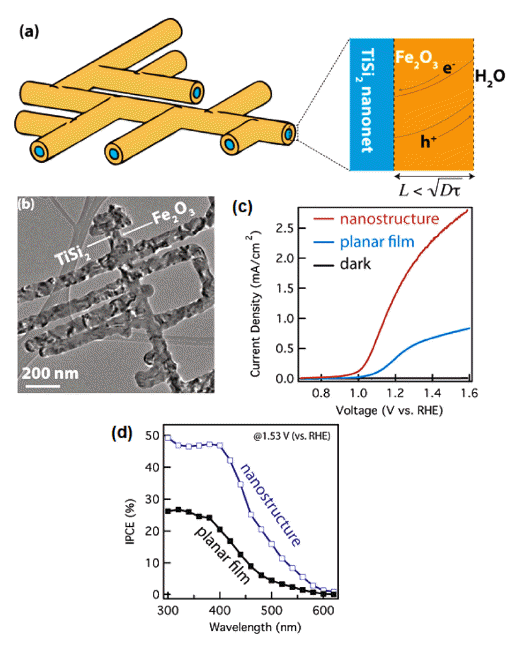
(a) Schematic illustration of the design principle, which involves the use of a highly conductive TiSi2 nanonet as an effective charge collector. The electronic band structure is shown in the enlarged cross-sectional view. Efficient charge collection is achieved when the hematite thickness is smaller than the charge-diffusion distance. (b) Low-magnification transmission electron microscopy (TEM) image showing the structural complexity of a typical heteronanostructure and its TiSi2 core/hematite shell nature. (c) Characteristic PEC data of an Fe2O3/TiSi2 heteronanostructure and a planar hematite film (d) Comparison of the external quantum efficiencies (IPCEs) of Fe2O3 with and without TiSi2 nanonets (measured at V = 1.53 V vs RHE). The introduction of a highly conductive component increases the IPCE significantly. Reproduced with permission [23], Copyright 2011, American Chemical Society.

Fig. 5
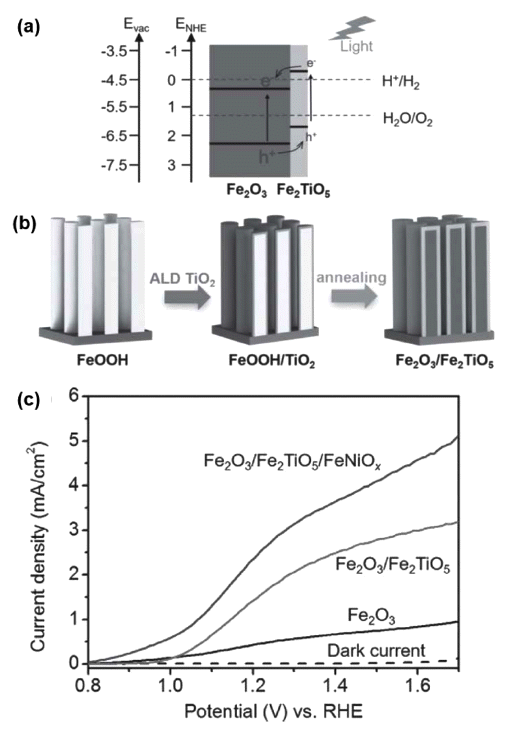
(a) Schematic band diagram of Fe2O3 and Fe2TiO5 (pH = 0) and the flow of charge carriers under illumination. (b) Schematic of the synthesis process of Fe2O3/Fe2TiO5 NRs. (c) Linear-sweep voltammograms of bare Fe2O3, Fe2O3/Fe2TiO5, and Fe2O3/Fe2TiO5/FeNiOx photoanodes. Reproduced with permission [26], Copyright 2016, John Wiley and Sons.

Fig. 6
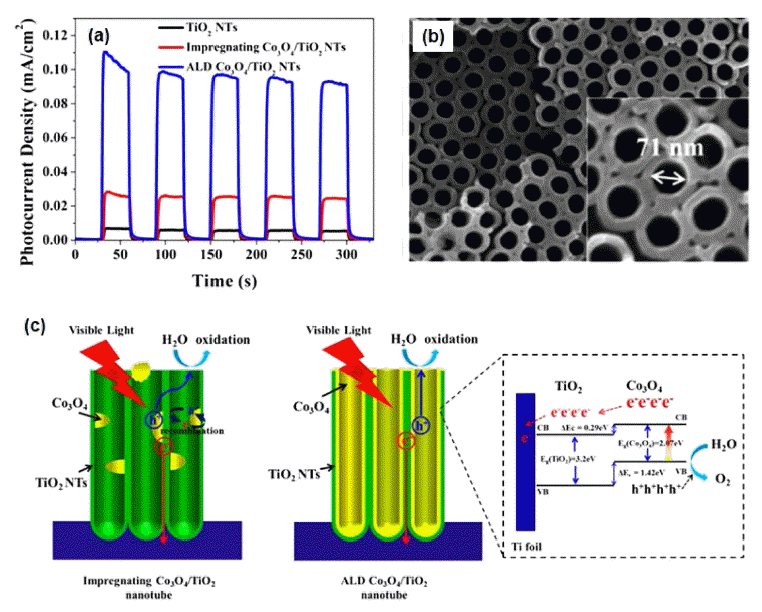
(a) Photocurrent density vs time of pristine TiO2 NTs, impregnation method prepared Co3O4/TiO2 NTs and 100 ALD cycles Co3O4/TiO2 NTs. Test condition: 100 mW/cm2 visible light illumination (λ > 420 nm) in 0.1M Na2SO4 solution. (b) SEM images of TiO2 NTs after 200 cycles of ALD cobalt oxide deposition (c) Schematic illustrating the charge separation and transfer under visible light for Co3O4/TiO2 NTs fabricated by impregnating method and ALD method. Reproduced with permission [32], Copyright 2015, American Chemical Society.

Fig. 7
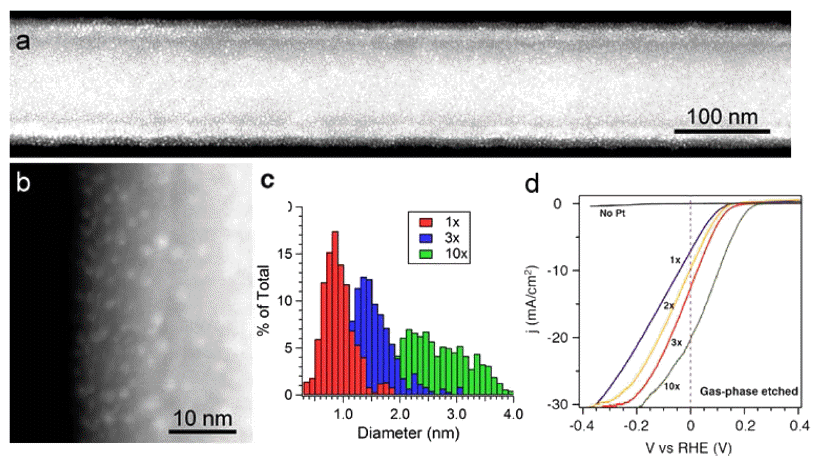
STEM analysis of Pt NPs deposited on Si/TiO2 core−shell NWs by ALD. High-angle annular dark-field STEM images of a NW after (a) 10 cycles and (b) 3 cycles of Pt ALD. (c) Histogram of particle size for various numbers of cycles. (d) HER performance (under 1 sun illumination) of Si NW array photocathodes synthesized via gas-phase etching and loaded with ALD Pt cocatalyst. Reproduced with permission [38], Copyright 2013, American Chemical Society.

Fig. 8
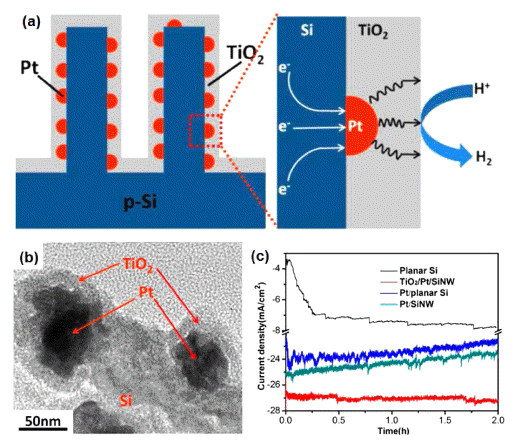
(a) Schematic and (b) TEM morphologies of the TiO2/ Pt/SiNW photoelectrode. (c) Chemical stability test on the photoelectrochemical reaction of the bare planar Si, Pt/ planar Si, Pt/SiNW and TiO2/Pt/SiNW samples in H2SO4 (0.5M) under 100 mW/cm2 illumination. The applied potential was −0.5 V (vs RHE). Reproduced with permission [48], Copyright 2015, American Chemical Society.

Fig. 9
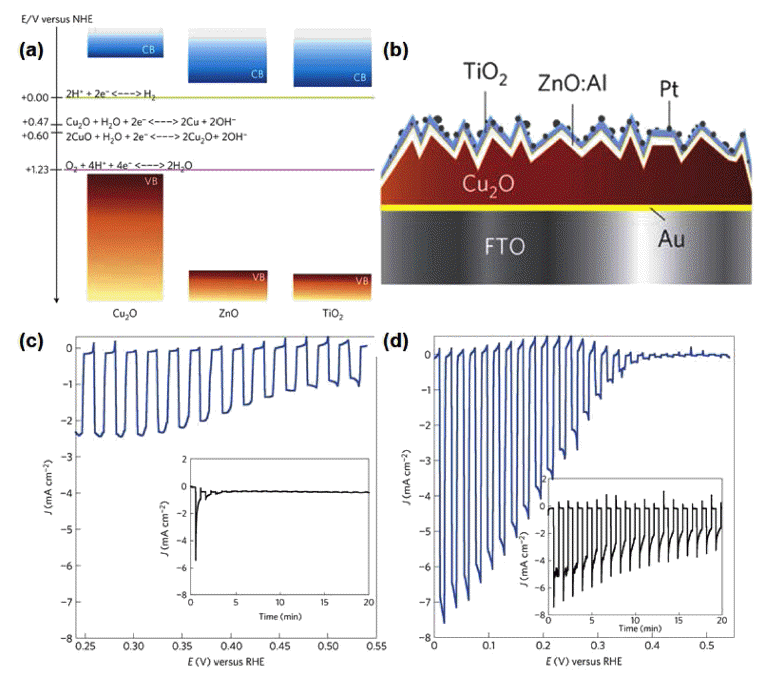
(a) Overview of the energy band positions for the semiconductors of the multilayer photocathode and redox levels of the involved chemical reactions. (b) Schematic representation of the electrode structure. (c) The photoelectrochemical response for (c) the bare and (d) surface-protected electrodebare. Reproduced with permission [51], Copyright 2011, Springer Nature.

- 광전기화학적 물분해를 이용한 수소 생성 제조 기술은 친환경적이며 고효율로 청정연료를 생산할 수 있는 기술 이며 이를 위해서는 정밀하게 제어된 광촉매전극 제조 기 술이 필요하다. 앞서 기술하였듯이 ALD의 우수한 두께 및 조성 제어, 3차원의 복잡한 구조의 균일한 표면 코팅 특성, pin-hole free한 박막 제조 특성 등을 통하여 보다 우 수한 성능의 수소 생성용 광전기화학셀의 개발이 진행되 고 있다. ALD를 이용한 광촉매전극 소재 연구 결과를 표 1에 요약하였다. 하지만 ALD를 이용하여 보다 고성능의 광전기화학촉매 전극을 개발하기 위해서는 대량으로 3차 원 나노 입자를 코팅할 수 있는 원자층 증착반응기의 개 발, 신규의 광촉매전극 코팅용 전구체 개발, ALD를 이용 한 나노 구조 제어기술, 표면 특성 개질 기술 등 다양한 연구 개발이 더욱 필요할 것으로 보인다.
- ALD materials for photoelectrochemical hydrogen evolution reaction.
요약 및 결론
Table 1
| 3-D structure electrode | Fe2O3 on TiSi2 nanonet [23], TiO2 on CNT [22], FexCo1-xS on CNT [25], TiO2 on FTO opal structure [24] Co3O4 on TiO2 nanotube [29] |
| Heterojunction structure | Si/TiO2 [21], Si/Fe2O3 [31], CdS/ZnO [27], TiO2/ZnO [28], TiO2/Co3O4 [32, 33], TiO2/Fe2O3 [30], Fe2O3/Fe2TiO5 [26], TiO2/In2S3 [34] |
| Co-catalyst | Pt [38, 39, 40, 41], Ru-Pt [42], Ru-Pd [42], Pt-Pd [42], NiS [44, 45], MoS2 [43] |
| Protecting layer | TiO2 [48], TiO2/ZnO [51], Al2O3 [49], SiO2 [49] |
-
Acknowledgements
- 이 연구는 서울과학기술대학교 교내 학술연구비 지원으 로 수행되었습니다.
감사의 글
- 1. J.D. Holladay, J. Hu, D.L. King and Y. Wang: Catal. Today., (2009) 139 244.Article
- 2. A. Fujishima and K. Honda: Nature., (1972) 238 37.ArticlePDF
- 3. N. Bao, L. Shen, T. Takata and K. Domen: Chem. Mater.., (2008) 20 110.Article
- 4. C. Santato, M. Ulmann and J. Augustynski: Adv. Mater.., (2001) 13 511.Article
- 5. J. Gan, X. Lu and Y. Tong: Nanoscale., (2014) 6 7142.Article
- 6. M. Ni, M.K.H. Leung, D.Y.C. Leung and K. Sunmathy: Renew. Sustain. Energy Rev.., (2007) 11 401.Article
- 7. R. Li, Y. Weng, X. Zhou, X. Wang, Y. Mi, R. Chong, H. Han and C. Li: Energy Environ. Sci.., (2015) 8 2377.Article
- 8. V. Pore, M. Ritala, M. Leskelä, S. Areva, M. Järn and J. Järnsröm: J. Mater. Chem.., (2007) 17 1361.Article
- 9. H.E. Cheng, W.J. Lee, C.M. Hsu, M.H. Hon and C.L. Huang: Electrochem. Solid-State Lett.., (2008) 11 D81.Article
- 10. S.J.A. Moniz, S.A. Shevlin, D.J. Martin, Z.X. Guo and J. Tang: Energy Environ. Sci.., (2015) 8 731.Article
- 11. X. Xu, Z. Gao, Z. Cui, Y. Liang, Z. Li, S. Zhu, X. Yang and J. Ma: ACS Appl. Mater. Interfaces., (2016) 8 91.Article
- 12. J. Han, X. Zong, X. Zhou and C. Li: RSC Advances., (2015) 5 10790.Article
- 13. Y. Tang, X. Hu and C. Liu: Phys. Chem. Chem. Phys.., (2014) 16 25321.Article
- 14. S. Hilliard, G. Baldinozzi, D. Friedrich, S. Kressman, H. Strub, V. Artero and C. Laberty-Robert: Sustainable Energy Fuels., (2017) 1 145.Article
- 15. S.U.M. Khan and J. Akikusa: J. Phys. Chem. B., (1999) 103 7184.Article
- 16. C.W. Lai and S. Sreekantan: Int. J. Hydrogen Energy., (2013) 38 2156.Article
- 17. G. Zhao, H. Kozuka and T. Yoko: Thin Solid Films., (1996) 277 147.Article
- 18. C. Liu, P. Li, G. Wu, B. Luo, S. Lin, A. Ren and W. Shi: RSC Advances., (2015) 5 33938.Article
- 19. K. Nagasuna, T. Akita, M. Fujishima and H. Tada: Langmuir., (2011) 27 7294.Article
- 20. R.L. Puurunen: J. Appl. Phys.., (2005) 97 121301.
- 21. Y.J. Hwang, A. Boukai and P. Yang: Nano Lett.., (2009) 9 410.Article
- 22. S.H. Huang, C.C. Wang, S.Y. Liao, J.Y. Gan and T.P. Perng: Thin Solid Films., (2016) 616 151.Article
- 23. Y. Lin, S. Zhou, S.W. Sheehan and D. Wang: J. Am. Chem. Soc.., (2011) 133 2398.Article
- 24. H. Zhang and C. Cheng: ACS Energy Lett.., (2017) 2 813.Article
- 25. W. Xiong, Z. Guo, H. Li, R. Zhao and X. Wang: ACS Energy Lett.., (2017) 2 2778.Article
- 26. C. Li, T. Wang, Z. Luo, S. Liu and J. Gong: Small., (2016) 12 3415.Article
- 27. D. Ma, J.W. Shi, Y. Zou, Z. Fan, X. Ji, C. Niu and L. Wang: Nano Energy., (2017) 39 183.Article
- 28. C. Cheng, H. Zhang, W. Ren, W. Dong and Y. Sun: Nano Energy., (2013) 2 779.Article
- 29. J. Zhang, Z. Yu, Z. Gao, H. Ge, S. Zhao, C. Chen, S. Chen, X. Tong, M. Wang, Z. Zheng and Y. Qin: Angew. Chem. Int. Ed.., (2017) 56 816.ArticlePDF
- 30. X. Yang, R. Liu, C. Du, P. Dai, Z. Zheng and D. Wang: ACS Appl. Mater. Interfaces., (2014) 6 12005.Article
- 31. M.T. Mayer, C. Du and D. Wang: J. Am. Chem. Soc.., (2012) 134 12406.Article
- 32. B. Huang, W. Yang, Y. Wen, B. Shan and R. Chen: ACS Appl. Mater. Interfaces., (2015) 7 422.Article
- 33. J. Kim, T. Iivonen, J. Hämäläinen, M. Kemell, K. Meinander, K. Mizohata, L. Wang, J. Räisänen, R. Beranek, M. Leskelä and A. Devi: Chem. Mater.., (2017) 29 5796.Article
- 34. S.K. Sarkar, J.Y. Kim, D.N. Goldstein, N.R. Neale, K. Zhu, C.M. Elliott, A.J. Frank and S.M. George: J. Phys. Chem. C., (2010) 114 8032.Article
- 35. Y. Lin, Y. Xu, M.T. Mayer, Z.I. Simpson, G. McMahon, S. Zhou and D. Wang: J. Am. Chem. Soc.., (2012) 134 5508.Article
- 36. J. Yu, L. Qi and M. Jaroniec: J. Phys. Chem. C., (2010) 114 13118–13125.Article
- 37. S.Y. Tee, C.J.J. Lee, S.S. Dinachali, S.C. Lai, E.L. Williams, H.K. Luo, D. Chi, T.S. Andy Hor and M.Y. Han: Nanotechnology., (2015) 26 415401.ArticlePDF
- 38. N.P. Dasgupta, C. Liu, S. Andrews, F.B. Prinz and P. Yang: J. Am. Chem. Soc.., (2013) 135 12932.Article
- 39. T.D. Gould, A.M. Lubers, A.R. Corpuz, A.W. Weimer, J.L. Falconer and J.W. Medlin: ACS Catal.., (2015) 5 1344.Article
- 40. R. Liu, L. Han, Z. Huang, I.M. Ferrer, A.H.M. Smets, M. Zeman, B.S. Brunschwig and N.S. Lewis: Thin Solid Films., (2015) 586 28.Article
- 41. C.C. Wang, Y.C. Hsueh, C.Y. Su, C.C. Kei and T.P. Perng: Nanotechnology., (2015) 26 254002.ArticlePDF
- 42. J. Lu, K.B. Low, Y. Lei, J.A. Libera, A. Nicholls, P.C. Stair and J.W. Elam: Nat. Commun.., (2014) 5 3264.
- 43. S. Oh, J.B. Kim, J.T. Song, J. Oh and S.H. Kim: J. Mater. Chem. A Mater. Energy Sustain.., (2017) 5 3304.Article
- 44. Y. Cimen, A.W. Peters, J.R. Avila, W.L. Hoffeditz, S. Goswami, O.K. Farha and J.T. Hupp: Langmuir., (2016) 32 12005.Article
- 45. A.W. Peters, Z. Li, O.K. Farha and J.T. Hupp: ACS Appl. Mater. Interfaces., (2016) 8 20675.Article
- 46. A.G. Scheuermann and P.C. McIntyre: J. Phys. Chem. Lett.., (2016) 7 2867.Article
- 47. M.F. Lichterman, M.R. Shaner, S.G. Handler, B.S. Brunschwig, H.B. Gary, N.S. Lewis and J.M. Spurgeon: J. Phys. Chem. Lett.., (2013) 4 4188.Article
- 48. S. Li, P. Zhang, X. Song and L. Gao: ACS Appl. Mater. Interfaces., (2015) 7 18560.Article
- 49. Q. Cheng, M.K. Benipal, Q. Liu, X. Wang, P.A. Crozier, C.K. Chan and R.J. Nemanich: ACS Appl. Mater. Interfaces., (2017) 9 16138.Article
- 50. Z. Zhang, R. Dua, L. Zhang, H. Zhu, H. Zhang and P. Wang: ACS Nano., (2013) 7 1709.Article
- 51. A. Paracchino, V. Laporte, K. Sivula, M. Grätzel and E. Thimsen: Nat. Mater.., (2011) 10 456.ArticlePDF
Figure & Data
References
Citations
Citations to this article as recorded by 

- Improved Interface and Electrical Properties by Inserting an Ultrathin SiO2 Buffer Layer in the Al2O3/Si Heterojunction
Doyeon Kim, Jae‐Young Choi, Sang Wook Ryu, Woo‐Byoung Kim
Advanced Functional Materials.2019;[Epub] CrossRef
Recent Developments in H2 Production Photoelectrochemical Electrode Materials by Atomic Layer Deposition









Fig. 1
Schematic of the basic principles of water splitting for a PEC cell with an n-type semiconductor photoanode (where oxygen is evolved) and cathode (where hydrogen is evolved). Reproduced with permission [5], Copyright 2014, Royal Society of Chemistry.
Fig. 2
Schematic illustration of one ALD reaction cycle, Reproduced with permission [20], Copyright 2005, AIP Publishing LLC.
Fig. 3
(a) SEM images of Fe0.54Co0.46S0.92/CNTs/CC electrodes. (b) LSV curves and (c) Tafel plots for FexCo1−xSy films with various compositions. The overpotentials (η) at −10mA/cm2 in current density and the values of the Tafel slopes are plotted in panels (d) and (e), respectively. The FexCo1−xSy films were grown by ALD on flat glassy carbon substrates. Reproduced with permission [25], Copyright 2017, American Chemical Society.
Fig. 4
(a) Schematic illustration of the design principle, which involves the use of a highly conductive TiSi2 nanonet as an effective charge collector. The electronic band structure is shown in the enlarged cross-sectional view. Efficient charge collection is achieved when the hematite thickness is smaller than the charge-diffusion distance. (b) Low-magnification transmission electron microscopy (TEM) image showing the structural complexity of a typical heteronanostructure and its TiSi2 core/hematite shell nature. (c) Characteristic PEC data of an Fe2O3/TiSi2 heteronanostructure and a planar hematite film (d) Comparison of the external quantum efficiencies (IPCEs) of Fe2O3 with and without TiSi2 nanonets (measured at V = 1.53 V vs RHE). The introduction of a highly conductive component increases the IPCE significantly. Reproduced with permission [23], Copyright 2011, American Chemical Society.
Fig. 5
(a) Schematic band diagram of Fe2O3 and Fe2TiO5 (pH = 0) and the flow of charge carriers under illumination. (b) Schematic of the synthesis process of Fe2O3/Fe2TiO5 NRs. (c) Linear-sweep voltammograms of bare Fe2O3, Fe2O3/Fe2TiO5, and Fe2O3/Fe2TiO5/FeNiOx photoanodes. Reproduced with permission [26], Copyright 2016, John Wiley and Sons.
Fig. 6
(a) Photocurrent density vs time of pristine TiO2 NTs, impregnation method prepared Co3O4/TiO2 NTs and 100 ALD cycles Co3O4/TiO2 NTs. Test condition: 100 mW/cm2 visible light illumination (λ > 420 nm) in 0.1M Na2SO4 solution. (b) SEM images of TiO2 NTs after 200 cycles of ALD cobalt oxide deposition (c) Schematic illustrating the charge separation and transfer under visible light for Co3O4/TiO2 NTs fabricated by impregnating method and ALD method. Reproduced with permission [32], Copyright 2015, American Chemical Society.
Fig. 7
STEM analysis of Pt NPs deposited on Si/TiO2 core−shell NWs by ALD. High-angle annular dark-field STEM images of a NW after (a) 10 cycles and (b) 3 cycles of Pt ALD. (c) Histogram of particle size for various numbers of cycles. (d) HER performance (under 1 sun illumination) of Si NW array photocathodes synthesized via gas-phase etching and loaded with ALD Pt cocatalyst. Reproduced with permission [38], Copyright 2013, American Chemical Society.
Fig. 8
(a) Schematic and (b) TEM morphologies of the TiO2/ Pt/SiNW photoelectrode. (c) Chemical stability test on the photoelectrochemical reaction of the bare planar Si, Pt/ planar Si, Pt/SiNW and TiO2/Pt/SiNW samples in H2SO4 (0.5M) under 100 mW/cm2 illumination. The applied potential was −0.5 V (vs RHE). Reproduced with permission [48], Copyright 2015, American Chemical Society.
Fig. 9
(a) Overview of the energy band positions for the semiconductors of the multilayer photocathode and redox levels of the involved chemical reactions. (b) Schematic representation of the electrode structure. (c) The photoelectrochemical response for (c) the bare and (d) surface-protected electrodebare. Reproduced with permission [51], Copyright 2011, Springer Nature.
Fig. 1
Fig. 2
Fig. 3
Fig. 4
Fig. 5
Fig. 6
Fig. 7
Fig. 8
Fig. 9
Recent Developments in H2 Production Photoelectrochemical Electrode Materials by Atomic Layer Deposition
| 3-D structure electrode | Fe2O3 on TiSi2 nanonet [23], TiO2 on CNT [22], FexCo1-xS on CNT [25], TiO2 on FTO opal structure [24] Co3O4 on TiO2 nanotube [29] |
| Heterojunction structure | Si/TiO2 [21], Si/Fe2O3 [31], CdS/ZnO [27], TiO2/ZnO [28], TiO2/Co3O4 [32, 33], TiO2/Fe2O3 [30], Fe2O3/Fe2TiO5 [26], TiO2/In2S3 [34] |
| Co-catalyst | Pt [38, 39, 40, 41], Ru-Pt [42], Ru-Pd [42], Pt-Pd [42], NiS [44, 45], MoS2 [43] |
| Protecting layer | TiO2 [48], TiO2/ZnO [51], Al2O3 [49], SiO2 [49] |
Table 1
ALD materials for photoelectrochemical hydrogen evolution reaction.
Table 1
TOP
 KPMI
KPMI

 Cite this Article
Cite this Article









